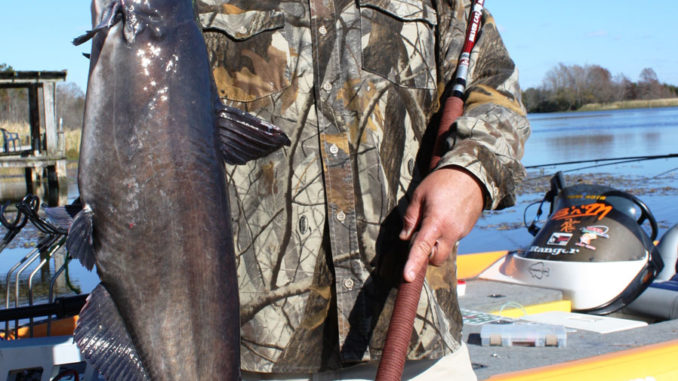
Great catfish can be shallow one day, deep the next, and biting all the time.
February’s weather can be tricky, with very cold but also very mild temperatures. That’s the primary reason why most experts use the term “transition” for catfish in the Santee Cooper lakes this month. Make no mistake, the action can be on fire during this cold month, but where the action is found is tracked directly to the weather.
Linwood Thornhill has been guiding at Santee Cooper for almost a half-century, and the 69-year-old knows the lakes as well as anyone. He said big catfish are there for the taking in February, but he often has to do more searching to produce excellent results.
Thornhill, who is headquartered at Blacks Camp, primarily fishes Lake Moultrie, and he has developed specific patterns for this lake compared to Lake Marion.
“One of the more-consistent fisheries during February is catfish,” Thornhill said. “The fishing is very weather-dependant as the fish begin transition from deep to shallow water. This transition to the shallow, warming water can create issues finding fish, but it does also present some great opportunities. The big issue for some is that the migration from deep to shallow doesn’t happen just once. Catfish can move in shallow, then back deep and then repeat the process, depending on the weather. When warm temperatures and bright skies warm the surface, the catfish will move to the shallows, and we usually catch a lot of really big fish.”
Thornhill said most anglers’ efforts in February involving targeting big blues.
“Early February will usually find me catching most of the catfish in deep water drift-fishing,” Thornhill said. “I’ll use the typical Santee drift rig, and when drifting, I vary the length of line behind the boat and the depths until I hit a pattern for the day.
“The key is to look for baitfish, because blue catfish will be around the forage, and usually I’ll find them along bottom contour changes in Lake Moultrie,” Thornhill said. “The lake is full of underwater hills and valleys, so I use my electronics to find areas where I mark forage and big fish then I drift it.”
Thornhill uses cut bait along with small white perch for big blue catfish. His preferred cut bait is herring and/or gizzard shad.
“By mid-February, when we get even a slight warming trend, the real fun starts, and the fish will make a big move to the shallow water,” Thornhill said. “The catfish will migrate toward the shallows and will offer exceptional shallow water action, usually in small depressions that are 5 to 8 feet deep but surrounded by shallow water. It’s basically a small, deeper hole in a large, shallow flat. Water temperature is the key, but expect movements from deep water toward the shallower water as the month progresses.”
Thornhill said the mouth of the Diversion Canal is another great February spot.
“We’ve usually got a lot of water flowing though the canal in February, and where the canal opens into Lake Moultrie can be a great place for catfish,” he said. “The key here is to anchor fish along the edges of the canal or on shallow humps near the mouth. The forage carried by the current in the canal can create good fishing, but the fishing here is sporadic in that it can be either a very early or mid-day pattern, but the hot action usually doesn’t last long on any given day. But when it’s on, it’s great. If I don’t get a bite quickly, I’ll move.”
Thornhill said shallow depressions are best fished by dropping an anchor on one side then drifting across to the other side or using an electric motor to minimize spooking shallow fish. He then drops another anchor on the far side and then pulls the boat back to the middle.
“This way, I’m locked in tight so the boat doesn’t move,” he said. “I fan-cast multiple rigs around the boat. Often, when conditions are right, by the time I’m baiting the second or third rod, we’ve got a fish hooked on the first rod.”
“We’ll catch big fish drift-fishing, but this shallow-water fishing is really the best opportunity during February to hook into some monster catfish,” he said. “A lot of 40- to 60-pound fish will be caught in the manner, sometimes even larger. But a cold snap can send me back to catching fish in deeper water. That’s the transition phase of February, but the deep water also has the potential to provide awesome fishing for giant blues.”
The fishing is also excellent in Lake Marion according to guide Alan Spence.
“Mobility is crucial in February to adapt to the weather and water conditions,” Spence said. “But make no mistake, there are lots of huge catfish caught on Lake Marion in February.”
Spence, 58, from Manning, has guided for 14 years and gathered enough know-how to follow the ever-changing water condition that February provides.
“I adapt where I fish daily,” he said. “I move around through the open-water areas in the lower end of Lake Marion, looking for a combination of baitfish and big fish marked on the graph. I set up by anchoring or tying to a stump or tree if it’s available and casting rigs all around the boat. At this time of the year, almost all my fishing is from an anchored position, and I’m casting rigs out on a flat line.”
Spence uses gizzard and threadfin shad for baits, he said, because they are the primary food source for blue cats this month.
“I will typically anchor and give the fish about 30 minutes or so to bite,” he said. “However, in muddy water, I will sit longer, sometime up to an hour. Contrary to what some fishermen think, the muddy water does not shut the catfishing down. The fish have to rely on their sense of smell, so I give them more time to find the baits.
“Depths and areas (where) I find fish will change based on weather and water conditions,” he said. “Some days, I’ll find fish close to the dam, but other days, I may be a few miles above the dam. Generally, the best depth for February in Lake Marion will be from 20 to 35 feet. It’s an ever changing process and that’s why I have to be mobile.
“I vary the hook size from 3/0, 5/0 and 8/0 used based on the size of bait,” he said. “I vary the bait size to determine if fish have a daily preference.”
Don’t let the idea that transition means tough fool you into staying home. As Thornhill and Spence said, this can be a trophy catfish month, but you may need a bit of patience to pinpoint the big, blue targets.
DESTINATION INFORMATION
HOW TO GET THERE — Access points around the Santee Cooper lakes are numerous. On the north side of Lake Marion, Manning is a prime destination. Take I-95 to Exit 119 and turn east on SC 261. The town of Santee is located close to both lakes on the south banks. Take I-95 to Exit 98 for Santee, then take SC 6 to the Diversion Canal area. On Lake Moultrie, both Moncks Corner and Bonneau offer quick access to the lake.
WHEN TO GO — iFebruary is a great month for both numbers and quality catfish on both Lake Marion and Lake Moultrie. It’s an excellent time to catch really big blue catfish, but you’ve got to be flexible in terms of the depth you fish, based on the weather.
WHERE TO FIND ‘EM — Catfish will typically begin the month in deep water, but as short warming trends and sunny days warm the shallows, big catfish will make quick forays into those areas. The next front, however, will likely push them back into deep water again.
FISHING INFO/GUIDES — Linwood Thornhill, Black’s Camp, 843-753-2231, www.blackscamp.com; Alan Spence, 803-478-5029. See also Guides and Charters in Classifieds.
ACCOMMODATIONS — infoBegin with Santee Cooper Counties Promotion Commission in Santee at 803-854-2131(www.santeecoopercountry.org) for complete information on both lakes Marion and Moultrie. Also contact South Carolina Association of Visitor bureaus (www.discoversouthcarolina.com) for additional lodging information around the lakes. Blacks Camp has full-service accommodations, guides, bait and restaurant.
MAPS — Navionics Electronic Charts, 6 Thatcher Lane, Wareham MA 02571; Delorme’s South Carolina Atlas & Gazetteer, 800-561-5105 or www.delorme.com; Kingfisher Map 800-326-0257, www.kfmaps.com.

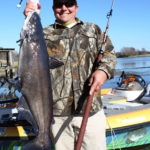
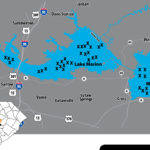
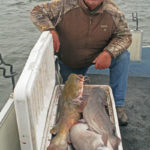
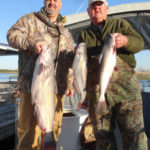




Be the first to comment